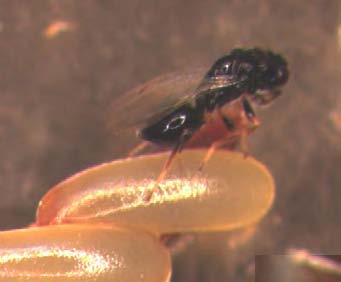PESTS AND DISEASES OF FORESTRY IN NEW ZEALAND
New Zealand's biological control process reviewed
Scion is the leading provider of forest-related knowledge in New Zealand
Formerly known as the Forest Research Institute, Scion has been a leader in research relating to forest health for over 50 years. The Rotorua-based Crown Research Institute continues to provide science that will protect all forests from damage caused by insect pests, pathogens and weeds. The information presented below arises from these research activities.
From Forest Health News 205, May 2010.
The Environmental Risk Management Authority (ERMA New Zealand) has released a review of the influence of the HSNO Act on the process of biological control. The review is based on questionnaire responses and discussions with biological control researchers, industry groups and other interested parties.
The Hazardous Substances and New Organisms (HSNO) Act was introduced in 1996 to regulate the introduction of new organisms, including biological control agents. ERMA New Zealand administers the Act by considering applications to introduce new organisms and provides an independent and transparent decision making process that allows for public participation. Prior to the HSNO Act coming into force, decisions on the introduction of biological control agents were made by senior officials in the Ministry of Agriculture and Forestry.
The review concludes that the HSNO Act is widely accepted by biological control scientists and provides a clear framework for decision making that is removed from political influence. The process thoroughly considers risks to the environment, biodiversity, human health and culture and the economy, and encourages science excellence and a conservative approach to risk. The HSNO Act is highly regarded internationally, as few other countries have such a transparent and structured process.

For industry however, the HSNO Act is seen to add costs to the process of biological control, putting it out of reach of smaller growers with insect pest or weed problems.
Eucalypt growers are a good example of this, being a small industry confronted by large numbers of pests arriving from Australia, for many of which biological control is the only appropriate control option.
There is no easy solution to the conflicts between the requirements of the application process and the costs to end users. Biological control scientists base their work on international best practice, which is increasing in complexity as we improve our understanding of how introducing a new organism can affect the environment. The New Zealand public tend to be risk averse, citing historic impacts of biological control, often without understanding current best practice and the many benefits. In addition, the HSNO Act deals with genetically modified organisms under the same process, resulting in biological control agents being treated with a similar degree of caution. Meanwhile growers are facing increasing threats from unregulated invaders that escape our biosecurity system, combined with pressure to reduce chemical usage. Biological control is the obvious solution in many cases, and is very cost effective in the long term, but obtaining funding to conduct the research needed to introduce a new agent, as well as application costs, can be restrictive.
The ERMA NZ report is available from http://www.ermanz.govt.nz/resources/rrr.html
Lisa Berndt
This information is intended for general interest only. It is not intended to be a substitute for specific specialist advice on any matter and should not be relied on for that purpose. Scion will not be liable for any direct, indirect, incidental, special, consequential or exemplary damages, loss of profits, or any other intangible losses that result from using the information provided on this site.
(Scion is the trading name of the New Zealand Forest Research Institute Limited.)



